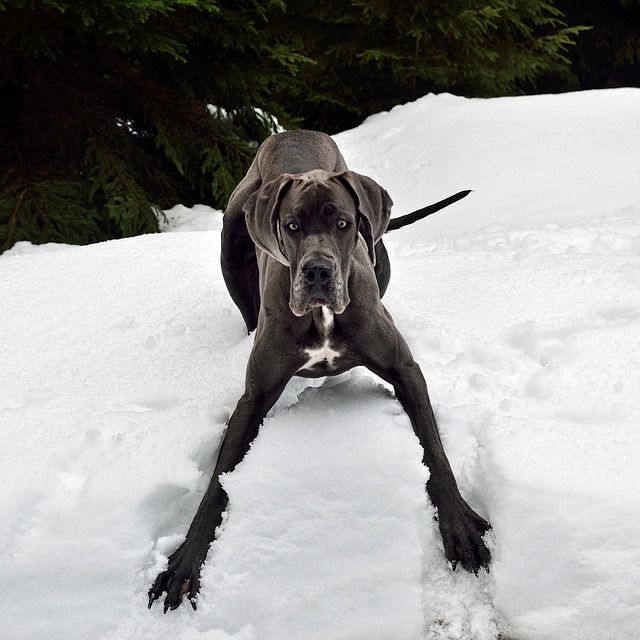


The Great Dane is a giant dog breed known for its impressive size and gentle nature. Often referred to as "the Apollo of dogs" due to their graceful appearance, Great Danes are friendly, affectionate, and calm, making them excellent companions for families and individuals alike. Despite their size, they are generally well-mannered, sociable, and patient. Great Danes are known for their loyalty and form strong bonds with their families, though their size can sometimes be overwhelming for smaller living spaces or inexperienced dog owners.
The Great Dane's origins date back to ancient times, with early ancestors believed to have been bred in Germany. These ancestors were likely a mix of mastiff-type dogs and greyhounds, which resulted in a breed that combined both strength and speed. Initially used for boar hunting and as guard dogs, they were valued for their imposing presence and hunting abilities. Over time, the breed's temperament shifted to be more gentle, and they became companions and watchdogs. The modern Great Dane was refined in Germany in the 19th century, where they gained popularity as noble and regal pets. Their larger-than-life stature has earned them the title of one of the tallest dog breeds in the world.
The Great Dane is a large and muscular breed with a striking appearance. They typically stand between 28 to 34 inches tall at the shoulder, with males often being taller and heavier than females. Great Danes can weigh between 100 to 200 pounds, depending on their size. Despite their immense stature, they have a well-proportioned body, with long legs and a deep chest that supports their strength and endurance. Their short coat comes in various colors, including fawn, brindle, blue, black, and harlequin (a unique patchwork pattern). Great Danes have large, expressive eyes and a long, elegant neck. Their ears are typically cropped in some countries, but in others, they are left natural and floppy.
Great Danes are often described as "gentle giants" due to their calm and friendly nature despite their imposing size. They are typically affectionate, good-natured, and social, getting along well with both people and other animals. They are known for their loyalty to their family members and are often very protective of their loved ones. Though they may seem intimidating due to their size, Great Danes are generally not aggressive and are typically calm in the home. However, they can be reserved or aloof with strangers, making early socialization important. They enjoy being part of the family and may not tolerate long periods of isolation, preferring to be around their human companions.
While Great Danes are large dogs, they do not require excessive amounts of exercise. They enjoy daily walks and some playtime, but they are not as high-energy as some other breeds. Because of their size, it's important not to overexert them, especially during their growing phase, to avoid stressing their joints and bones. A moderate amount of daily activity, including short walks and light play, is usually sufficient to keep them healthy and happy. As they mature, their exercise needs may decrease slightly, but maintaining a healthy weight is essential to prevent stress on their joints. Great Danes are also known to enjoy lounging around the house and will typically rest after their exercise sessions.
Great Danes are intelligent dogs, but due to their size, they require consistent training and firm leadership from an early age. Positive reinforcement methods, such as praise and treats, are effective for training. However, because they are so large, they must learn basic commands like "sit," "stay," and "leave it" early to prevent any unwanted behaviors. Socialization is crucial to ensure that they are comfortable around people, children, and other pets. If not properly socialized, a Great Dane can become overprotective or shy around new situations. Early exposure to different environments, people, and other animals will help them become well-adjusted companions.
Great Danes are generally healthy, but due to their large size, they are prone to certain health issues. Common conditions include hip dysplasia, bloat (gastric dilatation-volvulus), heart disease, and certain types of cancers. Regular veterinary checkups are essential to detect and address any health concerns early on. Great Danes require a nutritious, well-balanced diet to support their growth and maintain a healthy weight. They may be prone to obesity, so portion control and regular exercise are important. Grooming is relatively low-maintenance for the breed due to their short coat, but they do shed, so brushing once a week will help keep loose hair in check. Routine dental care, ear cleaning, and nail trimming are also important aspects of their care.
The average lifespan of a Great Dane is between 7 to 10 years, which is relatively short compared to smaller dog breeds. Their large size contributes to a faster rate of aging, and they are more susceptible to certain health problems. However, with proper care, including a balanced diet, regular exercise, and routine veterinary visits, some Great Danes can live longer, healthy lives. It is important for Great Dane owners to be proactive in monitoring their dog's health, as some conditions, such as bloat, require immediate medical attention to prevent serious complications.
© copyright Dog Compendium 2024 - 2025